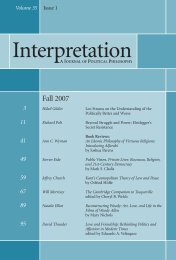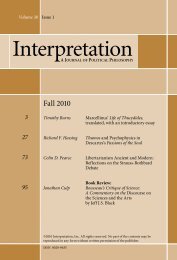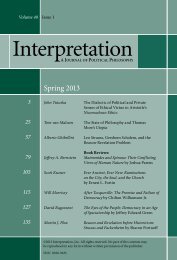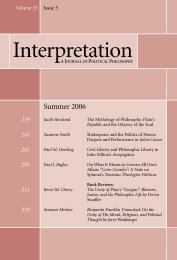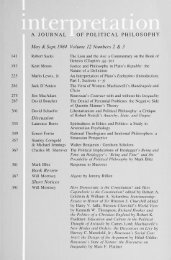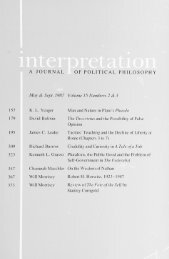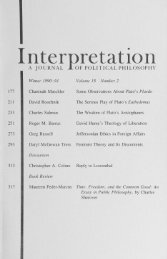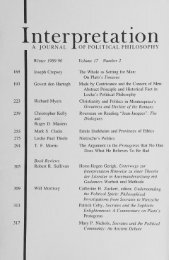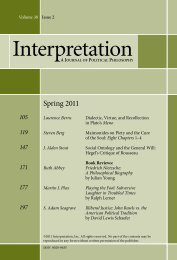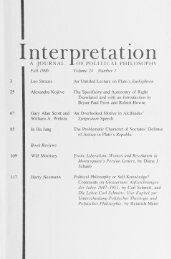Spring 2010 - Interpretation
Spring 2010 - Interpretation
Spring 2010 - Interpretation
You also want an ePaper? Increase the reach of your titles
YUMPU automatically turns print PDFs into web optimized ePapers that Google loves.
Creation as Parable in Maimonides’ Guide of the Perplexed<br />
2 6 3<br />
majority of cases when it interprets the Talmud in a superficial manner<br />
and destroys the literal sense of the text. One should not think,<br />
however, that I, in any way, Heaven forbid, actually believe them or<br />
what they stand for. Rather, it is the case that everything written proceeds<br />
according to its literal sense yet all of these things have within<br />
them a hidden essence—not the meaning of the philosophers who toss<br />
[the literal sense of the text] into the refuse, but the [inner essence] of<br />
the masters of truth.<br />
Although the above passage refers specifically to the interpretation<br />
of Talmudic texts, it applies as well to the biblical text. As Eliyahu<br />
Stern explains (2008, 19-23, with notes), the Vilna Gaon often interpreted<br />
the Torah’s text figuratively, but believed at the same time that no word in<br />
it is solely aesthetic or poetic. The Vilna Gaon would thus be objecting specifically<br />
to Maimonides’ distinction between parables in which each word<br />
requires interpretation and parables in which some terms may be regarded<br />
as poetic embellishments. So, for example, whereas the Vilna Gaon follows<br />
Maimonides in rejecting the implausible notion that Jonah was literally<br />
eaten by a whale and survived inside its stomach for days on end, reading it<br />
instead as an allegory about the human soul, his hermeneutic differs from<br />
Maimonides’ in that it never ignores the specific wording of the Jonah text.<br />
On the contrary, the Vilna Gaon justifies and explains the meaning of each<br />
and every word and verse, offering an account of why it, and it alone, could<br />
have been employed to express the allegorical idea in question. Maimonides,<br />
by contrast, as we see, permits himself, when he deems it appropriate, to omit<br />
from his allegorical accounts those elements of the text that strike him as<br />
superfluous or imprecise. (I thank Eliyahu Stern for his helpful elucidation of<br />
the Vilna Gaon’s hermeneutic divergence from Maimonides.)<br />
Let us, then, suppose that Maimonides’ most pressing aim<br />
in the Guide is to explain the obscure parable that is not obviously a parable,<br />
namely, the Account of the Beginning. That the issue of the world’s creation<br />
or eternity is the primary concern of the Guide should not take us by surprise.<br />
For, not only does Maimonides devote considerable space in the Guide<br />
to this matter, but he also makes it clear that the very character of the world<br />
depends on it: if the world is created it is a world of miracles, hope, and fear;<br />
if not, it is fully natural: there are no miracles, and there is no reason to hope<br />
for reward or to fear retribution (2.25:328).<br />
This is not to say, however, that Maimonides thinks that<br />
in a universe that is eternal there is no room at all for the Law (the Torah).<br />
Rather, it would seem, he recognizes two distinct conceptions of the Law that



